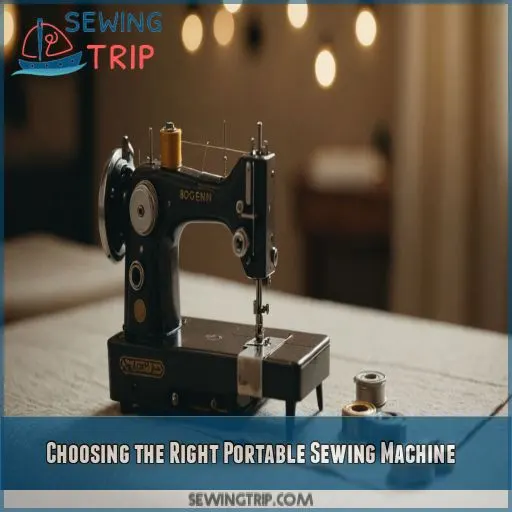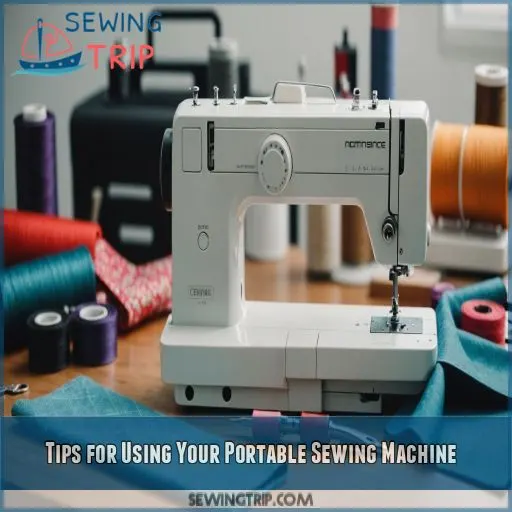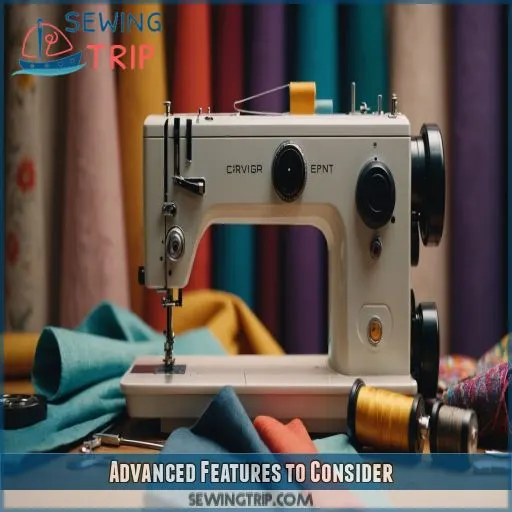This site is supported by our readers. We may earn a commission, at no cost to you, if you purchase through links.
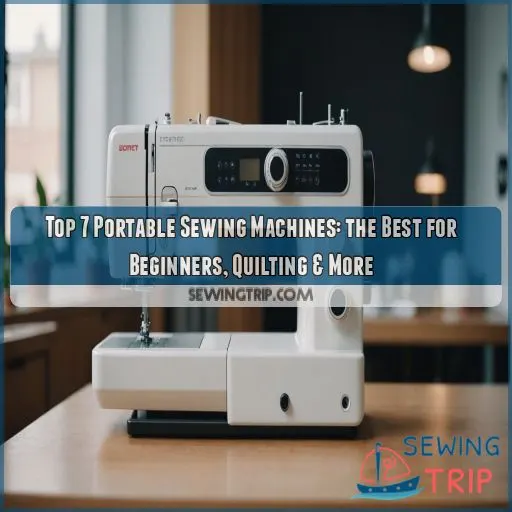 If you’re seeking a streamlined portable sewing machine, you’ve got options. These compact machines free you from the confines of electrical outlets, fitting neatly into your backpack or small storage space. Here’s a quick rundown of some top choices:
If you’re seeking a streamlined portable sewing machine, you’ve got options. These compact machines free you from the confines of electrical outlets, fitting neatly into your backpack or small storage space. Here’s a quick rundown of some top choices:
- Brother CS7000X: With 70 built-in stitches, a metal frame, and 7 one-step buttonholes, it’s a feature-rich option.
- Singer M1000: Weighing just over 5 pounds, this featherweight champ offers 32 stitch patterns and is ideal for those constantly on the move.
- Singer M3500: A super simple machine with over 3500 rave reviews for being easy to set up and use. It includes 11 stitches and a smooth automatic needle threader.
- Brother Computerized Sewing and Quilting Machine: Offering 165 built-in stitches, 8 auto-size buttonholes, and free arm capability, this machine packs a punch.
- Brother HC1850: This lightweight yet feature-rich machine includes buttonhole capabilities, multiple speeds, thread cutters, and a free arm.
Table Of Contents
Key Takeaways
- You’ve got options for portable sewing machines that won’t hold you back. Opt for lightweight, compact machines that free you up to create anywhere.
- Look for key features like a good range of built-in stitches, a lightweight design with a handle, automatic features, and essential accessories.
- Mechanical machines are perfect if you’re new to sewing, while computerized machines offer more stitch options for complex projects.
- Don’t forget to consider embroidery machines and sergers for detailed work and professional finishes.
Streamlined Portable Sewing Machines

If you’re in the market for a sewing machine that’s both portable and easy to use, you’re in luck. We’re breaking down the key features and benefits of streamlined portable sewing machines, so you can decide if this type of machine is the right fit for your needs.
Key Features to Look For
When choosing a portable sewing machine, look for these key features:
- Built-in stitches: Aim for at least 10-20 built-in stitches, including straight and zigzag options.
- Weight and size: Go for a lightweight machine with a handle for easy transport.
- Automatic features: Look for time-saving features like automatic needle threading.
- Accessories: Make sure it includes essentials like a bobbin, presser foot, and repair tools.
Benefits of Portable Sewing Machines
Now that you know what to look for in a portable sewing machine, let’s talk about the benefits of Sewing with Kids.
, let’s talk about the benefits! With a streamlined portable sewing machine, you’ll enjoy creative freedom to sew anywhere, anytime. Whether you’re a beginner or a seasoned pro, these compact designs offer the perfect blend of portability and functionality, making travel sewing a breeze.
Top 8 Portable Sewing Machines
Here are the top portable sewing machines that you can take with you wherever you go, perfect for beginners, quilters, and anyone who wants to create on the move. From compact and lightweight to feature-rich and powerful, these machines are designed to make sewing easy, convenient, and fun.
1. Brother CS7000X Sewing Machine
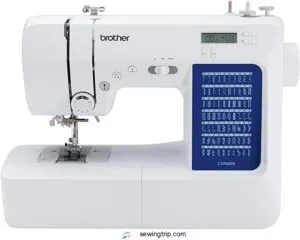
You’re looking for a great portable sewing machine that can keep up with your creativity. The Brother CS7000X is an excellent choice, featuring 70 built-in stitches, including utility, decorative, and quilting stitch functions. This machine has a metal frame and a fixed needle bar for durability. It includes 7 one-step auto-size buttonholes and an improved automatic needle threader, making it a breeze to use. With its wide table, 10 sewing feet, and quilt guide, you’ll be stitching like a pro in no time.
Best For: The Brother CS7000X is best for quilters, crafters, and home sewers who want a durable and versatile machine with a wide range of features.
- 70 built-in stitches, including utility, decorative, and quilting stitches
- Durable metal frame and fixed needle bar
- Includes a wide table, 10 sewing feet, and quilt guide
- Only available in the US at 120 volts
- No automatic thread cutter
- Limited accessories included
2. Singer M1000 Sewing Machine 32 Stitches
If you’re a beginner or a quilter, the Singer M1000 Sewing Machine 32 Stitches is a great choice. This portable machine is lightweight, easy to use, and comes with 32 built-in stitches, including straight stitch and zigzag options. The transparent bobbin and cover allow you to monitor your thread supply, and the easy-to-follow threading guides make it easy to set up your machine. Perfect for mending and light sewing, this machine is a great addition to any sewing room.
Best For: The Singer M1000 Sewing Machine 32 Stitches is best for beginners, quilters, and those looking for a lightweight and portable machine for mending and light sewing projects.
- Lightweight and portable design.
- Easy to use with 32 built-in stitches.
- Transparent bobbin and cover for easy thread monitoring.
- Some users reported issues with thread breaking and difficulty threading the needle.
- The machine may struggle with thicker fabrics and heavy-duty sewing.
- Some users reported issues with the motor slowing down and the light dimming.
3. Singer M3500 Sewing Machine
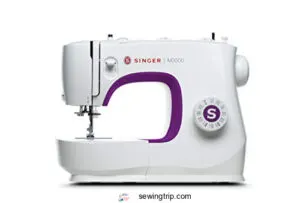
The Singer M3500 sewing machine is an excellent choice for beginners and experienced sewers alike. Weighing just 11.79 pounds, this machine is easy to transport and store. With 110 stitch applications, you can tackle various projects, from basic stitches to decorative and stretch stitches. The built-in stitch application guide makes sure you always know which stitch to use for the job. Plus, the automatic needle threader makes threading a breeze, saving you time and effort.
Best For: The Singer M3500 is best for beginners and sewers who want a lightweight and easy-to-use machine with a wide range of stitch options.
- 110 stitch applications for a variety of projects
- Automatic needle threader for easy threading
- Lightweight and easy to transport
- Some users have reported issues with bobbin jamming
- The machine may require some initial setup and learning
- Instructions may not be sufficient for complete beginners
4. Singer 7285Q Quilting Sewing Machine
As a quilter, you need a sewing machine that delivers high-quality results every time. The Singer 7285Q Quilting Sewing Machine is designed with you in mind, featuring 100 built-in stitches, including 15 quilting stitches, and a top drop-in bobbin for easy threading. With automatic needle threader and programmable needle up/down, you can focus on creating beautiful quilts, not wrestling with the machine. Trust the Singer 7285Q to deliver precision and performance.
Best For: The Singer 7285Q Quilting Sewing Machine is best for quilters who want a machine with a wide variety of stitches and features, including automatic needle threading and a top drop-in bobbin.
- Features a wide variety of stitches, including 15 quilting stitches.
- Includes an automatic needle threader and programmable needle up/down.
- Features a top drop-in bobbin for easy threading, similar to the Effortless Threading System found in some sergers. .
- Some users have reported issues with the machine locking up and error code C4.
- Customer support may not be helpful in resolving technical issues.
- Some users have reported issues with the automatic needle threader and buttonhole function.
5. Brother Computerized Sewing Quilting Machine
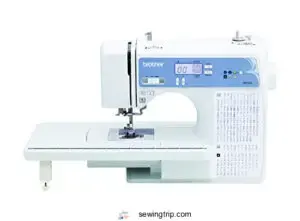
You’re considering the Brother Computerized Sewing and Quilting Machine.
This machine offers a wide range of features, including:
- 165 built-in stitches
- 8 auto-size buttonholes
- Free arm capability for sewing cuffs and sleeves
It also comes with a drop-in top bobbin, making it easy to thread.
With a lightweight design and a sturdy machine body, this is a great option for quilters and sewers.
It’s perfect for beginners who want a machine that can grow with them.
Best For: This machine is best for beginners and intermediate sewers who want a versatile machine with a wide range of features.
- Lightweight but sturdy machine body.
- Drop-in clear bobbin case.
- Many quick-change presser feet.
- Hard case is not a carrying case, but a hard plastic dust cover with no bottom.
- Styrofoam inside top of case should not be removed.
- Some users find the number of optional settings overwhelming.
6. Brother SE700 Embroidery Sewing Machine
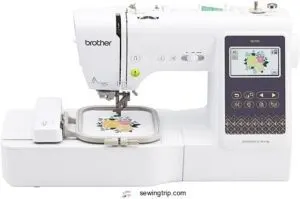
You’re looking for a machine that can handle both sewing and embroidery? The Brother SE700 is a great option. This compact machine features a built-in 4" x 4" embroidery field, automatic needle threading, and 135 built-in designs. Sync your smartphone with the Artspira app to create custom embroidery patterns and transfer them wirelessly. Plus, its 3.7-inch LCD touchscreen allows easy editing and design preview. With a built-in USB port and wireless LAN connectivity, you can easily transfer designs between your machine and your computer.
Best For: The Brother SE700 is best for beginners or anyone looking for a compact machine with both sewing and embroidery capabilities.
- Easy to use and great for beginners.
- Wireless connectivity and Artspira app allow for convenient design creation and transfer.
- Automatic needle threading and jam-resistant bobbin make for a smoother sewing experience.
- Thread spool holder can lead to tangling and thread breakage.
- Some users have experienced issues with tension and needle breakage.
- Customer service has been reported as unhelpful and unresponsive.
7. Mini Sewing Machine for Kids
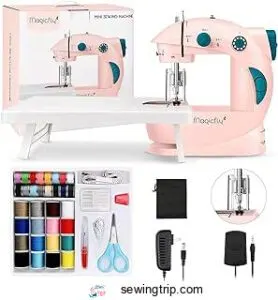
If you’re looking for a sewing machine to get your kids started, the Mini Sewing Machine is a solid choice. It’s small, lightweight, and simple to use, making it perfect for beginners.
This electric machine supports AC/DC power or batteries, and it’s easy to turn on with a button or the included foot pedal. It has dual-speed functionality and a double thread design for stronger stitching. You can adjust the speed to "high" or "slow" with the speed button.
The machine comes with a practical sewing kit that includes bobbins, needles, scissors, a threader, tape measure, seam ripper, thimble, and an extension table. It’s also pre-threaded and marked with threading directions, making it even easier for kids to get started.
Keep in mind that this machine isn’t meant for professional use or heavy-duty projects. It has limited stitch types and no automatic needle-threading. Some users have also reported issues with tension adjustment, jamming, and durability.
Best For: This sewing machine is best for beginners, especially kids, who are looking for a simple and fun way to learn the basics of sewing.
- Small and compact, making it easy to store and transport.
- Comes with a complete sewing kit, including everything you need to get started.
- Easy to use, even for beginners.
- Limited stitch types and no reverse function.
- Some users have reported issues with tension adjustment, jamming, and durability.
- Not suitable for heavy-duty sewing projects.
8. Singer Heavy Duty Sewing Machine
The Singer Heavy Duty 4452 is a powerful machine designed for a range of projects, from lightweight sheers to thicker fabrics like denim and leather. With its strong motor, you’ll have the piercing power and speed to sew through multiple layers with ease.
It offers 110 stitch applications, including basic, stretch, and decorative stitches, plus a one-step buttonhole. The top drop-in bobbin is jam-proof and easy to monitor, while the built-in needle threader makes threading a breeze.
The full metal frame provides stability and durability, and the adjustable presser foot pressure lets you work with a wide range of fabrics.
The Singer Heavy Duty 4452 is a robust and versatile machine, perfect for both beginners and experienced sewers alike.
Best For: The Singer Heavy Duty 4452 is best for sewers of all levels who need a machine that can handle a variety of fabrics and projects.
- Powerful motor for sewing through multiple layers of fabric.
- 110 stitch applications for versatility.
- Built-in needle threader for easy threading.
- Some users report issues with the walking foot.
- Thread clumping can be a problem.
- Lacks certain features like needle down and zig-zag stitch capabilities.
Choosing the Right Portable Sewing Machine
When shopping for a portable sewing machine, you’re likely overwhelmed by the numerous options available. You know you need a machine that’s lightweight, easy to maneuver, and offers the features you need to tackle your sewing projects with confidence.
Mechanical Vs Computerized Machines
Mechanical vs computerized sewing machines: which one’s right for you? When choosing a portable sewing machine, consider your skill level, sewing needs, and budget. Mechanical machines are streamlined, easier to understand, and perfect for beginners, while computerized machines offer more features and stitch options, ideal for quilting and complex projects.
Embroidery and Sergers: What’s the Difference?
You’re caught up in mechanical and computerized sewing machines, but now you’re curious about embroidery and sergers. Here’s the lowdown: Embroidery machines are designed for intricate designs and detailed patterns, typically with a built-in digitizing system. Sergers, on the other hand, are used for professional-grade binding, finishing raw edges, and decorative stitches.
Embroidery Projects to Try:
- Monogrammed handkerchiefs
- Customized patches
- Decorative pillow covers
- Personalized baby blankets
Automatic Features to Consider
When choosing a portable sewing machine, consider the following automatic features to enhance your sewing experience:
| Feature | Description |
|---|---|
| Automatic needle threading | Saves time and reduces frustration |
| Buttonhole makers | Creates professional-looking buttonholes with ease |
| Presser foot options | Allows for custom presser feet for specific tasks |
| Tension control | Adjusts stitch length and tension with precision |
Weight and Size: Portability Matters
When choosing a portable sewing machine, consider how you’ll be using it often. Opt for a machine that’s lightweight and compact, with an ergonomic handle that makes it easy to carry around. Look for sleek designs with storage solutions, greatly reducing clutter and making organization a breeze, while ensuring top-tested features at an affordable price point.
Tips for Using Your Portable Sewing Machine
Now that you’ve chosen the perfect portable sewing machine, it’s time to get the most out of it. To achieve a smooth sewing experience, you’ll want to set up your machine correctly, To achieve a smooth sewing experience, you’ll want to set up your machine correctly, master basic sewing techniques, and know how to troubleshoot common issues that may arise.
, and know how to troubleshoot common issues that may arise.
Setting Up Your Machine for Success
Setting up your portable sewing machine for success is easy. Here are four tips to get you started:
- Familiarize yourself with the parts of your machine, such as the power switch, spool pin, thread guide, and bobbin winder.
- Read the manual to learn about threading the machine and needle, and follow the instructions for your specific model.
- Choose the right serger needle type for your fabric and insert it securely, paying attention to the flat side and groove direction.
, paying attention to the flat side and groove direction.
- Practice sewing on notebook paper to get a feel for the machine’s power and your control over it.
Mastering Basic Stitches and Techniques
Now that your machine is all set up, it’s time to master some basic stitches and techniques. Whether you’re a beginner or a pro, you need to know the fundamentals of hand sewing and the most common machine stitches.
First, let’s talk about hand sewing. The basic stitches you should know include the slip stitch, running stitch, catch stitch, blanket stitch, whipstitch, and backstitch. These stitches are perfect for mending, hemming, and other simple projects. When hand sewing, always use a needle and thread that are appropriate for your fabric. For example, use a finer needle for delicate fabrics.
Next, let’s explore some essential machine stitches. The most common stitches you’ll find on your portable sewing machine are:
- Straight stitch: This is your go-to stitch for most projects. It’s strong, accurate, and versatile.
- Zigzag stitch: Great for stretch fabrics and finishing edges. Play with the width and length to see the flexibility it offers.
- Three-stitch zigzag: Even stretchier than the standard zigzag, perfect for sewing elastic or darning.
- Overlock/overedge stitch: Mimics an overlocker, wrapping the thread around the fabric’s edge. Use it with an overedge foot for best results.
- Blind hem stitch: Ideal for long, straight hems where you don’t want visible stitching.
Don’t be intimidated by the variety of stitches. With a bit of practice on scrap fabric, you’ll soon get a feel for which stitches work best for different projects. Remember, the straight stitch and zigzag stitch will be your go-to options for most sewing tasks.
Troubleshooting Common Issues
Troubleshooting is an essential skill for any sewist. Sooner or later, your machine will jam, and you’ll need to know how to fix it. Here are some common issues and quick fixes to get you back to your project in no time.
- Remove any fabric and gently tug it to free trapped threads.
- Lift the presser foot and unthread the machine, then rethread with the presser foot up.
- Check your manual for correct threading.
- Make sure the presser foot is up when threading to prevent tension disks from engaging and blocking the thread.
Needle Problems
- Check for a bent or broken needle and replace.
- Use the correct needle for your fabric type. A ballpoint needle is best for knits, and a sharp needle for woven fabrics.
- Re-insert the needle, following your manual. The flat side typically goes to the back.
Thread Tension
- Adjust the tension if stitches are too loose or tight.
- If the top stitches are fine but the bottom ones are loose, increase the top tension. If the top ones are loose, lower it.
Bobbin Issues
- Check the bobbin is inserted correctly and not jammed.
- Make sure the bobbin thread is pulled through the sensor guide.
- Adjust the bobbin case tension with the screw.
Skipped Stitches
- Try a different needle type or size.
- Pre-treat fabrics to remove excess sizing, which can clog the needle.
- Avoid forcing the fabric through, let the feed dogs do the work.
Maintenance and Storage Tips
Keeping your portable sewing machine in tip-top shape is a breeze with these simple steps:
- Cleaning: Give your machine a quick wipe-down with a soft cloth after each use to remove any dust or lint.
- Lubrication: A drop of sewing machine oil in the right spots can keep things running smoothly. Consult your machine’s manual for specific instructions.
- Dust covers: Invest in a good-quality dust cover to keep your machine clean and protected when not in use.
- Storage space: Allocate a dedicated storage space for your machine, preferably in a cool, dry place away from direct sunlight.
- Transport safety: When travelling with your portable machine, use a sturdy case or bag to protect it from bumps and knocks.
Advanced Features to Consider
If you’re looking for advanced features, you’ll want to look at dual touchscreens, high-speed sewing, and advanced embroidery and quilting capabilities. You might also consider automatic thread tension and memorized needle up/down functions, as well as high-end materials and construction.
Dual Touchscreens and High-Speed Sewing
Now, let’s shift gears and explore some truly advanced features that can take your sewing to the next level. Are you ready to get into the nitty-gritty of dual touchscreens and high-speed sewing? Let’s go!
The Janome Continental M17 is a powerhouse in terms of advanced features. It boasts not one, but two touchscreens, with a 5.3 x 8.5-inch LCD and a 3.8 x 2.1-inch LCD. This machine offers an incredible 1,230 built-in embroidery designs and 450 built-in stitches, ensuring you have endless creative possibilities. But that’s not all; it also has a maximum sewing speed of 1,300 SPM for straight stitches and 1,000 SPM for zigzag stitches, so you can sew like the wind!
If you’re looking for high-speed sewing, the Continental M8 Professional has got your back. With a maximum sewing speed of 1,300 SPM, it’s an industry leader. Plus, it has an intelligent feed system, ensuring your fabric is positioned perfectly. The Janome M8 also features a full-color LCD touchscreen for intuitive stitch selection and a superior needle threader to save time and reduce eye strain.
Now, let’s talk about the Janome Memory Craft 6700P. This machine offers a sewing speed of up to 1,200 SPM, 200 stitches, and five alphabets, giving you plenty of creative freedom.
Advanced Embroidery and Quilting Capabilities
If you’re looking for advanced embroidery and quilting capabilities, the Janome Continental M17 stands out as a true industry leader. It boasts the largest embroidery space in the industry, with a hoop size of 11" x 18.1", giving you unmatched flexibility in your designs. Additionally, with over 1,200 built-in embroidery designs, you’ll have endless creative possibilities.
If you’re looking for a 2-in-1 machine that offers both embroidery and sewing capabilities, the Janome Horizon Memory Craft 9850 is an excellent choice. It provides 200 built-in stitches for all your sewing projects and 175 built-in embroidery designs, ensuring you have a wide range of options for any creative endeavor.
For quilting specifically, the Janome Memory Craft 6700P is worth considering. It offers the fastest stitching speeds in the industry for a top-loading bobbin machine, reaching 1,200 stitches per minute. This machine also includes the AcuFeed Flex Layered Fabric Feeding System, ensuring smooth quilt piecing for advanced quilting techniques.
Automatic Thread Tension and Memorized Needle Up/Down
Automatic thread tension and the memorized needle up/down function are advanced features that further enhance your sewing experience. Let’s take a closer look at the benefits of these features and how they work.
Automatic thread tension systems, available on some computerized machines, take the guesswork out of tension adjustments. They automatically adjust the tension based on your selected stitch type, fabric, and thread, ensuring consistent and balanced stitches. No more fiddling with tension dials!
The memorized needle up/down function gives you precise control over the needle’s position when you stop sewing. You can set the needle to stop in the up or down position, or even program it to remember your preferred setting. This feature is a game-changer when turning corners, adjusting fabric, or pivoting. No more manually raising or lowering the needle!
High-End Materials and Construction
When investing in a sewing machine, you want to make sure it’s built to last.
Look for machines with heavy-duty steel materials and fully tempered parts.
This combination of high-end materials and advanced construction techniques ensures a durable, reliable machine.
The Continental M17, for example, is a robust machine built for speed and precision.
Its computerized components and touchscreen interface showcase modern evolution of sewing machine technology.
.
Frequently Asked Questions (FAQs)
How much should I spend on a portable sewing machine?
If you’re new to sewing, a machine under $300 is a great starting point. You can always upgrade later when you’ve mastered the basics and know what features you want.
What features should I look for in a portable sewing machine?
When buying a portable sewing machine, look for built-in stitches, size, ease of use, included accessories, and type of machine. Go for a mechanical model with a straight stitch, zigzag stitch, and buttonhole function. Check for smooth movement, stitch quality, and tension adjustment ease. Make sure it’s lightweight, fits your budget, and has the features you need.
Are portable sewing machines good for beginners?
Yes, portable sewing machines are great for beginners. They’re usually lightweight, simple to use, and have the basic features you need to get started. Look for an intuitive design, a range of stitches, and accessories like a carrying handle.
Can I bring a portable sewing machine on a plane?
You can bring a portable sewing machine on a plane, but it’s best to check with your airline. The machine can go in your carry-on or checked baggage, but it must fit the overhead bin or under the seat. Strip it down and pack it safely to prevent damage.
What are the best portable sewing machines for quilting?
For quilting on the go, you need a machine that’s easy to carry and can handle multiple fabric layers. Check out these top picks:
- Juki TL-2000Qi: Heavy-duty, high-speed machine with a large extension table, perfect for quilting.
- Brother CS7000X: Offers great value with 70 stitch styles and an extendable work table.
- Singer 9960 Quantum Stylist: Beginner-friendly with 600 built-in stitches and portable design.
- Heureux Z6: Lightweight at 6 pounds, includes an automatic needle threader and quick-set bobbin.
- Janome 2212: Beginner-friendly, with adjustable stitch capabilities, and compact at 6 pounds
, adjustable stitch width and length, and compact at 6 pounds.
Conclusion
Now that you’ve read about the top portable sewing machines on the market, you’re probably excited to get your hands on one and start crafting. Whether you’re a beginner or an experienced crafter, these machines offer something for everyone. Remember to think about your needs, budget, and skill level when making your choice. Happy sewing!

